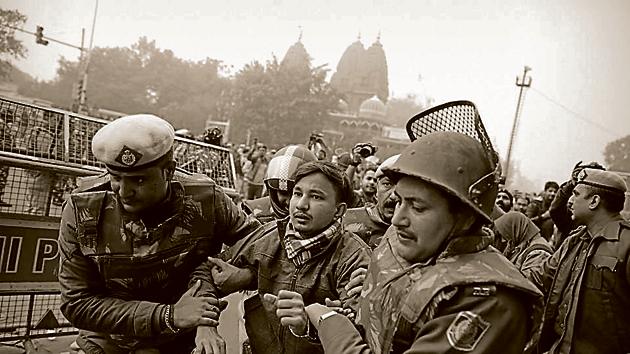How Section 144 and Internet shutdowns shrink democratic rights | Opinion
The State’s increasing use of the two instruments undermines the Constitution. Review this usage
The passage of the Citizenship Amendment Act by Parliament has triggered significant protests and demonstrations across the country. This is unsurprising — and indeed, should be welcomed. In a flourishing democracy, non-violent protest against a controversial State action is an accepted form of engagement between citizens and the government. In India, specifically, we have a long tradition of dissent and protest, going back centuries, whether political, social, or cultural.

Unfortunately, however, the government’s response to protests has been authoritarian. It has taken two forms: The imposition of Section 144 of the Code of Criminal Procedure (CrPC) in multiple states, and the shutting down of the Internet (also in many parts of the country).
Section 144 of the CrPC has its origins in colonial legislation (it was re-enacted in the 1973 CrPC). Essentially, Section 144 authorises executive magistrates (often, representatives of the police) to pass “prohibitory orders” that restrict people from assembling at particular places. An order under Section 144 is often accompanied by a reference to “unlawful assemblies” under the Indian Penal Code; for the most part, therefore, Section 144 orders prohibit gatherings of more than four people in a given area. The underlying logic is that breaches of public order, or the triggering of violence, can be prevented if people are stopped from gathering.
Now, there is little doubt that, in principle, there may be occasions where assemblies may need to be curtailed or regulated. For example, if a mob is assembling, and people intend to deliver incendiary speeches encouraging that mob to engage in violence and arson, naturally, the State and the police will need to act preventively. The problem, however, is that Section 144 is framed in such broad and vague terms, and with so little meaningful oversight, that it essentially allows the executive very wide discretion in prohibiting assemblies. In effect, therefore, it is no longer a shield against violence, but a sword to prevent the expression of dissent through public demonstrations and protests.
What legal standards govern the use of Section 144? Over the years, the Supreme Court has clarified that, given the importance of freedom of speech and expression in a democracy, restrictions upon these constitutional rights are permissible only if there is a “direct” or “proximate” link with the violence or public disorder. In other words, the State can take preventive action if there is a clear case of incitement to violence or riots — but it cannot do so on a mere “apprehension” that public disorder might result from protests. In the latter case, it is the State’s job to ensure that adequate security arrangements are in place, that allow protests to proceed in a non-violent fashion.
In practice, however, this standard is almost never adhered to. This is evident from the widespread use of Section 144 over the last few days. For example, Section 144 was imposed in the entire city of Bengaluru — covering 8.6 million people — without any indication that there existed a well-founded fear of violence in Bengaluru. Indeed, the Bengaluru police cited disorder in other parts of the country, and the potential “inconvenience” that protests might cause, to justify the Section 144 order. Neither of those arguments, however, are permissible under our Constitution.
In other parts of the country, the problem has been even starker. For example, Section 144 was imposed in all of Uttar Pradesh –— thus denying a state of two hundred million people their constitutional right to protest. This is an extremely disturbing trend, as the purpose of Section 144 was always to prevent imminent and localised threats to public order. Thus, city-wide and state-wide Section 144 orders are nothing more than a wholesale suspension of fundamental rights — the kind only seen during an Emergency.
Section 144 orders have also been accompanied with Internet shutdowns. These shutdowns are authorised by the Telecom Suspension Rules of 2017, passed under the colonial-era Indian Telegraph Act. The procedure for suspending the Internet is entirely bureaucratic in nature, and with no substantive oversight. It is unsurprising, therefore, that India leads the world in Internet shutdowns — ahead of countries such as China, Pakistan, Iran, Chad, and Egypt. What is particularly concerning about Internet shutdowns is not only the severe disruption that they cause in an era where the Internet is indispensable to daily life, but that — as research has shown — there is no connection between Internet shutdowns and containing violence (indeed, the correlation is the opposite).
Recent weeks, therefore, have revealed an alarming shrinking of democratic space through the use of Section 144 and Internet shutdowns. It is worth remembering, however that, at this exact point, the longest Internet shutdown in the history of any democratic country, is still going on in Kashmir (137 days). The Supreme Court has reserved judgment on the case. Its verdict — expected in January — could go some way towards restoring — and protecting — the most valuable of fundamental rights under our Constitution.






